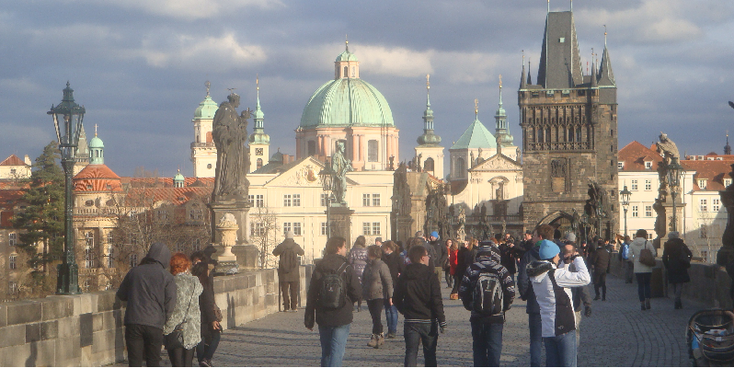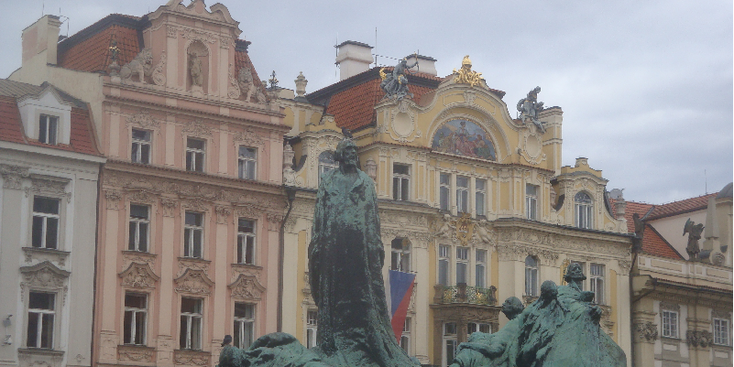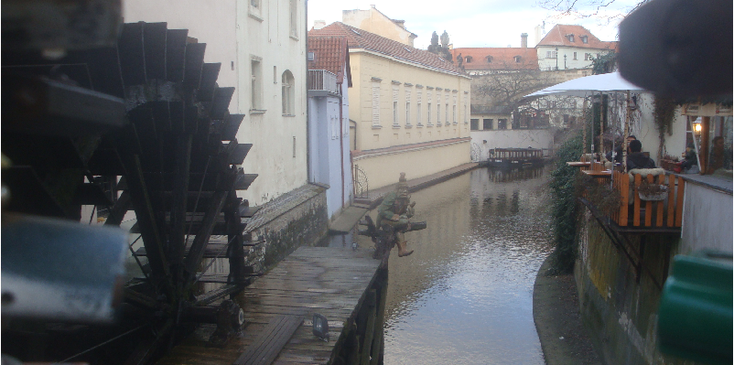Prague
Places of Interest - Czech Republic


introduction
Prague is the capital and largest city of the Central European country Czech Republic. The city is considered one of the most beautiful cities in Europe and the historic center is on the UNESCO World Heritage List. It is also the fifth most touristic city in Europe. The city originated from a number of small communities and then it became together a large historic city center; you can visit two beautiful medieval castles built on hills overlooking the river “Vltava”.
The golden city or city of the hundred towers as the city is sometimes affectionately named has dozens of small narrow streets and alleys paved with cobblestones flanked by beautiful Baroque and Gothic buildings in all kinds of colors and styles. You will also find streets with beautiful "Art Nouveau" buildings. In the old Jewish quarter "Josefov" you can visit one of the many synagogues or the oldest Jewish cemetery in Europe.
Prague also houses countless churches, cathedrals, museums and you can show your respect to the victims of the Lidice village, which is located just outside the city. Because few sights in Prague were destroyed during the Second World War, the city has been one of the biggest tourist attractions in Europe since the fall of the Iron Curtain and it attracts every year more tourists from all over the world.
highlights

Hradcany en Mala Strana:
The most popular landmark in Prague is the castle (of Prague), which is the largest castle from the Middle Ages. Consisting of three courtyards, history goes back to the 9th century when Bohemian kings chose it as their residence. Built on a hill overlooking the city and the river towers the St.Vitus cathedral.
The most famous street of the castle complex is the "golden street" where goldsmiths had their workshops and has now become a souvenir Paradise.
The district Mala Strana is located at the foot of the castle and here you will find the Royal route (Nerudova street) which is flanked by beautiful Baroque buildings of every style and color. It is not surprising that celebrities like Mozart and Casanova stayed here and this neighborhood is often chosen for film and TV recordings. On the most famous square of the district with the name of the same name stands the stately church of "St. Nicolas” with his amazing green dome.
Even though the entire neighborhood is worth strolling around, you can visit the "Wallenstein" garden in case of time, enjoy the view from the "Petrin" tower or take a walk in one of the city "parks of the “Kampa" island or an honorable visit to the" Lennon "wall.

Stare Mesto and Josefov
The heart of Prague is the old town square in the historic old town "Stare Mesto" where countless tourists gather for the archaeological clock. They all wait patiently for the hour when things are moving around in the clock. Part of this district is the Jewish ghetto called Josefov.
Unfortunately, the old ghetto walls have been demolished for centuries, but you can still taste the old atmosphere of the past here. Many synagogues and the oldest Jewish cemetery can also be found here. Highly recommended is to take a look at the "Spanish" synagogue which is called the most beautiful in Europe.
But lovers of architecture can also indulge in the Parizska street where you can see beautiful Art Nouveau. Perhaps the most beautiful bridge in Europe is located between the "Royal" district and the "old city" – “Charles” bridge named after the former Emperor IV. The bridge, now accessible only to pedestrians, is flanked by many Biblical statues and is adorned on both sides by two beautiful medieval towers.
Also in this neighborhood you can wander around for hours through small alleys, cobblestoned streets filled with countless churches and small (souvenir) shops in beautiful old colored Baroque and Gothic buildings.

Nove Mesto
Even though this neighborhood is called "new city" most of the buildings are from the 19th and 20th century and are anything but "new". The former place where the "horse market" was held is now THE place to change the history of the Czech Republic. Here the independence of Czechoslovakia was declared in 1918 but also the end of communism in 1989.
On the steps of the National Museum it was where that many students set themselves in flames in the sixties to protest against the communist regime. In the street Masarykovo Nabrezi are the most beautiful Art Nouveau buildings of the city where especially the "Goethe" institute stands out. Near the largest square of the city (Charles Square) you can find the church of Cyril & Methodius.
It was here where the assisinators of nazi-head "Reinhard Heydrich" were hiding when they were betrayed and fought for their lives in the church and its crypt. Surrounded and without hope for a good outcome, they made an end to their own lives. There is now a small museum and you can visit the crypt.
Other attractions:
- The castle Vysehrad and park Letna.

history
Archaeological finds show that there was already life in the area where now Prague is located 4000 years ago. In the 1st century n.C. Germanic tribes took over the place of a Celtic tribe while in the 6th century the first Slavic tribes reached the province of Bohemia and settled in the area where later Prague would be founded. In the beginning of the 9th century, work began on the construction of Prague Castle, after which settlements immediately began to emerge in the area of the current district Mala Strana.
In the 11th and 12th centuries German and Jewish merchants as well as indigenous craftsmen settled down along the Vltava, between the two castles. An important reason for choosing this location was that there was a crossing of important trade roads and a stone bridge over the river. In 1287 a few of those settlements were merged and surrounded by a new wall and thus the Old Town (Staré Město, Altstadt) was created. During the reign of Charles IV and his son Wenceslaus IV, the city quickly became more important and larger.
The goal of both rulers was the expansion of Prague to the new residence of the entire German Empire (Holy Roman Empire). In 1526 the Habsburgs took over. The Habsburgs would rule Bohemia without interruption until 1918, making Prague the second capital of the Habsburg Empire. Under Emperor Rudolf II, in 1583, Prague became emperor residence again and thus the center of cultural life in Central Europe. The emperor also allowed Jews to settle (again) in Prague, namely in the district (ghetto).

On 28 October 1918 (after WWI) the autonomy of Czechoslovakia was declared, with Prague as its capital. After the British and French signed the Munich agreement in exchange for peace and left the Sudetenland to Nazi Germany, German troops invaded the Czech Republic on 15 March 1939. Prague became the capital of the Protectorate of Bohemia and Moravia.
In the Second World War the city was scarcely damaged, because the Allied Air Force did not consider it as a German city. Unlike Pilsen, Prague also did not have a major war industry. On May 5, 1945, the inhabitants of Prague were called to revolt by radio. On that same day the army of the American general Patton arrived in Pilsen (only a few hours away from Prague), while the Soviet army of Marshal Konev was at the border of Moravia. General Patton was a proponent of liberating Prague, but General Eisenhower's instructions were different.
Eisenhower had asked the Soviet leadership to allow him to advance to Prague, but he was told that American help was not necessary. At the Yalta Conference it was agreed that the Red Army would liberate Bohemia, so it happened. On 9 May 1945, Prague was finally reached by the Soviet army. The German-speaking Jewish community of Prague disappeared as most of the Jews had disappeared from Prague. After the war, the German population of Prague, after several hundred Germans and collaborators had been executed on the streets, was interned and deported, as far as they had not yet fled.
Since Slovakia, which has been independent since 1940, has also been lifted politically, Prague could now again become the capital of Czechoslovakia. With the coup of February 25, 1948, the Communist Party of Czechoslovakia seized political power. There followed a time of oppression, which only became somewhat moderate in the 1960s. 1968 was the year of the Prague Spring, but in August of that year, this peaceful moderation attempt was severely crushed by the Soviet Union, Poland, Hungary and Bulgaria, four partners from the Warsaw Pact. The most famous protest against the Soviet occupation is the symbolic self-immolation of Jan Palach in Prague on January 16, 1969.
In 1989, after the Berlin Wall had fallen and the Velvet Revolution had taken place, Czechoslovakia in 1989 was liberated from communist influences. Prague profited enormously from the new situation, resulting in strong economic growth. In 1993, after the split of Czechoslovakia in the Czech Republic and Slovakia, Prague became the capital of the Czech Republic. In the year 2002, Prague, along with other large parts of Central Europe, was hit by floods of the Moldau. Among other things, the metro network and the district of Karlín were severely affected by the high water.

tips & advice (1996, 2014 and 2015)

Most international trains depart from "Praha Hlavni Nadrazi" while domestic trains also arrive or depart from "Masarykovo Nadrazi". The same counts for bus traffic - most buses (international but also the intercities) arrive and depart from "Florenc" station - easily accessible by metro. There are three metro lines (colors) but there is also a tram, local bus and city bus around. You can buy a tram ticket for half an hour (24 Czk) or an hour and a half (32 Czk).
Prague - Terezin: with tram 12 you can go to the station "Nadrazi Hoelsovice" (24 CZK) where about every hour a bus leaves (1 hour) to the city Terezin. First you will have to walk all the way to the other side of the metro station where there is a bus station. At platform 7 buses (about 1x per hour) go to the city of Terezin. Cost 88 CZK single.
Prague - Lidice: from station "Dejvicka" (accessible via the green metro line) you can take a bus (every 20 minutes) to the village Lidice "(duration about 20 to 30 minutes) - there are buses that go directly - others pass numerous stops. I paid 33 CZK for a ticket and bus A22 to the city "Kladno".
Prague - Tabor: the bus to the city of Tabor can be taken at various stations from the capital - "Florenc", central (train) station or "Roztyly". There is at least a direct bus from the last station at 9:30 (arrival 10:50) with direction "Ceske Budejovice". There are also buses at 11:20, 12:45 and 13:30 - all last about 1,5 hours. Costs between 96 CZK and 103 CZK. There are also trains, but they seem to be more expensive.
Prague - Kutna Hora: there are only trains to Kutna Hora. These go from the central station and go every 2 hours (08:00, 10:00, etc.) also on Sunday. The journey takes a little over an hour. Cost: 210 CZK for a return ticket. There are two train stations in KH - one is called "mesto" and is in the city itself - the other is about 3 to 4 km away in the suburb "Sedlec". Small trains run between these two stations.

-
Name: Armadni muzuem Zizkov (army museum Prague)
Address: U Pamatniku 2
Price: free entrance
Website: www.vhu.cz
Content:
The museum is centrally located near the main bus (Florenc) and train station. Situated in an old Soviet building, it looks cold and gray from the outside. Also the courtyard is not very inviting. Inside it is the other way around - the man behind the reception speaks German and English, among other things, and he explains which route to walk and makes a little chat.
This exhibition highlights are the first, second and (from February 2003) the third (anti-communist) resistance organization in the years 1914-1918 and 1939-1945, the history of the Czechoslovak army (1918-1939) and the persecution of members of the Czechoslovakian army after the February coup d'état in 1948. Besides weapons, you will also find many unique historical uniforms, flags, orders, awards and personal relics of the Czechoslovak presidents and important representatives of Czechoslovakia.
At the time that I was there, there was also an extra exhibition about the WWI - the attack on crown prince "Franz Ferdinand".


Of course, in a metropolis like Prague you can eat and drink whatever you want, especially in the center. But the prices are pretty high and especially in the center (tourist part). Just before (on the castle side) of the Charles Bridge is a good sausage shop. Close to Malonstranska Namesti is a small Asian eatery - Sichuan. Delicious meals from 80 Czk can be ordered here.
Not nice to sit but you can also take it with you. Another tip is the Asian restaurant "Shun Feng hai Yuan" on the Charles Square - you can order an excellent meal for 88 CZK. There is also a good supermarket and also a "Billa" supermarket.

-
Name: Hostel Aparcay backpackers
Address: Nerudova 40
Price: 140 CZK (during the week), 190 (weekend) dormitory of 16 beds
Phone nr. : +420 251 552 297
Website: www.arpacayhostel.com
Content:
A very popular (because of the location and the prices) hostel situated on the Royal road in a beautiful building. The hostel offers several rooms; I have stayed a couple of times in the cheapest. Sixteen beds in an ensuite room - for a change with extremely strong wooden bunk beds and good mattresses.
You get a towel and bed linen and there is free WIFI. A fine breakfast (unlimited food) is served for 75 CZK and there is a shared kitchen, TV room and a kind of lobby. Under the beds are large safes (rolling boxes) for your stuff with a lock for which you pay 10 euros deposit. Staff is professional and friendly.
-
Name: Hostel Sir Toby's
Address: Delnicka 24
Price: 200 Czk on average (dormitory mixed of 12 beds)
Phone nr. : + 420 246 032 611
Website: www.sirtoby.com
Content:
This large professional hostel is located just outside the city center (about 3 to 4 km) - you can easily reach the city center by tram and metro. It has a lobby with very friendly and very professional staff and this has all the information. There stands also three free PCs with internet. Downstairs in the basement is the common room that is furnished as a very cozy bar where you can get a beer in the evening.
There is also a kitchen for guests and a large breakfast for 120 CZK. You can sit in the bar even if you do not order anything. The hostel has at least 4 floors and there is an elevator. I slept on the third floor in the 12bed mixed dorm which has 4 bunk beds of 3 meters high. They have a private light and electrical plugs. The heating is pretty hot, there is a small water tap and WIFI in every room. In the corridor there are two large showers (including a toilet) and a separate toilet.
When I was there (February) the hostel was by no means full - due to the season and because of the reasonable high price for the location which was lovely.

see also:
LANDEN:
EUROPA:
Albanië * België * Bosnië-Herzegovina * Bulgarije * Denemarken * Duitsland * Engeland * Estland * Finland * Frankrijk * Griekenland * Hongarije * (Noord) Ierland * Italië * Kosovo * Kroatië * Letland * Litouwen * Luxemburg * Macedonië * Malta * Montenegro * NEDERLAND * Oekraïne * Oostenrijk * Polen * Portugal * Roemenië * Rusland * Schotland * Servië * Slovenië * Slowakije * Spanje * Tsjechië * Turkije * Zweden
NOORD EN CENTRAAL-AMERIKA:
Chili * Costa Rica * Cuba * Guatemala * Mexico * Nicaragua * Panama * Verenigde Staten
ZUID-AMERIKA:
Argentinië * Bolivia * Brazilië * Colombia * Ecuador * Peru
AFRIKA:
Botswana * Burkina Faso * Egypte * Ethiopië * Ghana * Kenia * Mali * Marokko * Namibië * Oeganda * Senegal * Tanzania * Tunesië * Zuid-Afrika
MIDDEN-OOSTEN:
Iran * Israël * Jordanië * V.A.E.
AZIE:
Armenië * Cambodja * China * Filipijnen * Georgië * India * Indonesië * Japan * Kirgizië * Laos * Maleisië * Mongolië * Myanmar * Nepal * Oezbekistan * Singapore * Sri Lanka * Thailand * Vietnam
OCEANIE:
Voor meer reisfoto's kijk op www.instagram.com/cheapskatetravel.nl:
© Cheapskatetravel.nl; 2018 (all rights reserved)


